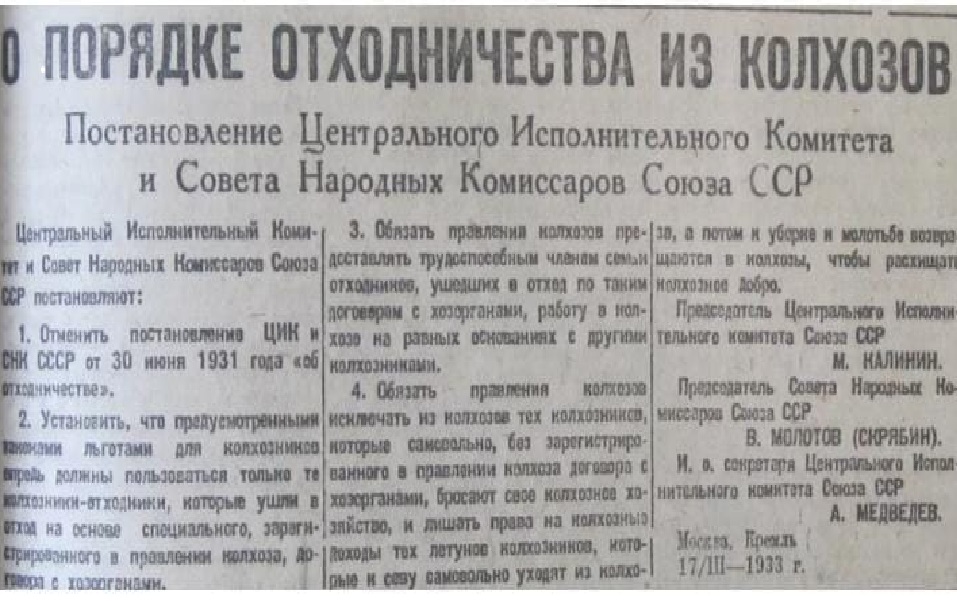Soviet migration in the context of passportization in the early 1930s.
Research Article
Views: 208 / PDF downloads: 69DOI:
https://doi.org/10.32523/3080-129X-2025-151-2-64-80Keywords:
seasonal migrant labor, migrants, economic labor drafts, passportization, passport, restricted-access areas, non-restricted areas, industrialization, urbanizationAbstract
The purpose of the article is to study the traditional phenomenon of seasonal migration from the Russian villages, namely the temporary departure of rural residents from their permanent homes for work. In the 1920s and the first half of the 1930s, it underwent transformation aimed at establishing state control over labor migration, particularly from the village, and organizing the supply of workers to industry. The study shows that throughout the 1920s, the Soviet government attempted to limit the spontaneous movement of the rural population, seeing it as a reason for rising unemployment and worsening socio-economic conditions in cities. To combat unregulated movements within the country and to evenly provide the industry with labor, the state implemented a system of economic recruitment. However, by the late 1920s to 1930s, unemployment was replaced by a “staff shortage”, and the demand for labor first exceeded supply. This shift required the authorities to introduce new measures to ensure the growing industry had enough workforce. Therefore, before the beginning of the passportization campaign, two channels for hiring workforce from the village remained economic recruitment and seasonal migration, but for peasants who signed contracts with economic authorities, agricultural benefits were introduced to attract them to participate in the seasonal migration. Concurrently, due to the policy pursued by the Bolsheviks in the villages and the onset of famine, the problem of mass outflow of population from villages worsened. This led to disruptions in commodity supply, intensifying the housing crisis, and leading to an increase in criminal activity in cities. Administrative documentation often classified such migrants were also referred to as seasonal migrants, although they were not related to labor migration. In the context of the flight of peasants, the government took measures aimed at keeping village residents in the villages and socially cleansing cities by introducing passports - a kind of filter whose possession granted the right to reside in cities, especially in restricted areas. New documents were not issued to rural residents, which limited their mobility across the country. Now, to leave the village, a peasant was required to provide documents confirming their intention to engage in “socially useful labor” in production, institutions, schools; documents of this kind included a job invitation, a recruitment contract, a certificate from the collective farm's administration about the departure, etc. The introduction of the passport system effectively transformed seasonal migration from a spontaneous labor migration into a system of organized supply for the industrial sector, while mass movement from the village was prohibited under the threat of administrative and repressive measures against violators of the new regime.
Downloads
References
Baiburin A. The Soviet passport: History ‒ structure ‒ practices. Saint Petersburg: EUSPb. 2017. 488 р.
Vdovin А., Drobizhev V. The growth of the working class: 1917-1940. Moscow: Mysl. 1976. 264 р
Famine in the USSR. 1929-1934. In 3 volumes. Vol. 1. Book 2. Moscow: MFD. 2011. 656 р.
Kessler H. Collectivization and flight from the countryside are socio-economic indicators. 1929-1939. 1n: Economic History. The review. Moscow. 2003. Is. 9. pp. 77-79..
Kondrashin V., Mozokhin O. MTS political departments in 1933-1934. Moscow: Russian Book. 2017. 397 p.
Moiseenko V. The departure of the rural population to work in the USSR in the 1920s. Population. 2017. No.3(77), рр.53‒54. http://10.26653/1561-7785-2017-3-4
Popov V. Passport system in the USSR (1932-1976). Sociological research. 1995. No.8, рр.3−14.
Popov V. The passport system of Soviet serfdom. Novy Mir. 1996. No.6, рр.185−203.
Potapova N. State regulation of otkhodnichestvo in the 1920s. (based on materials from Siberia Historical Courier. 2023. No.1(27), рр.178−185. URL: http://istkurier.ru/data/2023/ISTKURIER-2023-1-14.pdf DOI: https://doi.org/10.31518/2618-9100-2023-1-14
The history of industrialization of the USSR 1926-1941. Documents and materials. In 4 books. Book 1. 1926-1928. Moscow: Nauka Publ. 2005. 838 р.
The national economy of the USSR for 70 years: Jubilee statistical Yearbook. Goskomstat of the USSR. Moscow: Finance and Statistics. 1987. 766 p.
The Soviet village through the eyes of the CHEKA‒OGPU‒NKVD. 1918-1939. Documents and materials. In 4 volumes. Vol. 3. Book 2. Moscow: ROSSPEN. 2005. 838 p.
Chernolutskaya E. Forced migration in the Soviet Far East in the 1920s and 1950s Vladivostok: Dalnauka. 2011. 511 p.
Fitzpatrick S. " Attribution to class" as a system of social identification. Russia and the Modern World. 2003. No.2, pp.133-151.
Shirer D . Stalin's Military Socialism: Repression and Public Order in the Soviet Union, 1924-1953. Moscow: ROSSPEN, 2014. 541 p.

Published
Issue
Section
License
Copyright (c) 2025 N. Potapova

This work is licensed under a Creative Commons Attribution-NonCommercial-NoDerivatives 4.0 International License.














